Flowable Hub User Guide
Introduction
Flowable Hub is the management application in Flowable Cloud. The platform is divided into two core areas:
-
Management: Configure users, groups, and application permissions to ensure the right people have the right access.
-
Environment: Monitor and control runtime environments, deploy new apps and investigate runtime or historical data for your tenant.
In the future, Hub will supersede Flowable Control for on-premise deployments, too.
Management
The Management section of Flowable Hub allows to configure who can do what across the various environments. New users can be onboarded, permissions can be added or removed, assign roles, manage group memberships, and define privileges.
In addition to access control, Management also provides real-time visibility into the applications deployed within your environment. This means you always know what’s running, where, and who has access.
Applications
To fully leverage Flowable Hub’s permissions management, it helps to first understand how an environment is structured. Flowable Cloud is organized into three key application:
-
Work – where runtime execution and task management takes place.
-
Design – where models and definitions are created.
-
Hub – administrative insight and configuration.
Work is available in both Production and Sandbox environments. Design is configured to be able to publish to each environment, allowing you to test out models in the sandbox environment before promoting it to the production environment.
These applications are listed in the permissions interface, allowing you to assign access across one or more environments.

Users
Through the User menu, you can add, edit, or remove users—giving you full control over who can access your environment and what they can do.
Each user profile includes identity fields such as First Name, Last Name, Display Name, and Email or External ID, making it easy to manage access across teams and roles.
Filtering
Flowable Hub makes it easy to find exactly who you're looking for. At the top of the User Management screen, you'll find a filtering bar that lets you quickly narrow down the list based on user attributes.
Just below the filter, you'll see a complete list of users currently registered:

Create User
To add a new user, simply click the Create User button located to the right of the filtering bar.
The user creation form allows you to enter key details such as First Name, Last Name, Display Name, and Email or External ID. You can also assign roles across the Work, Design, and Hub applications—ensuring each user has the right level of access from the start.
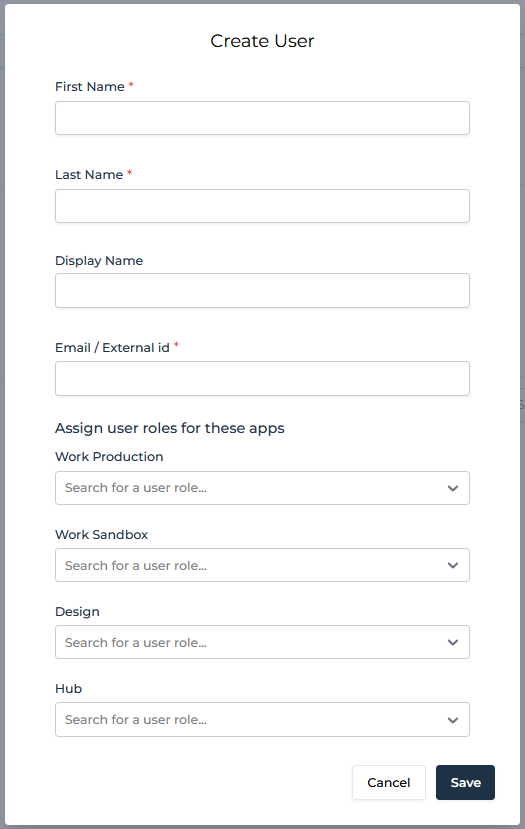
Edit/Delete User Profile
Managing user access is just as easy as creating it. From the user list, you can quickly edit user details or remove users entirely.

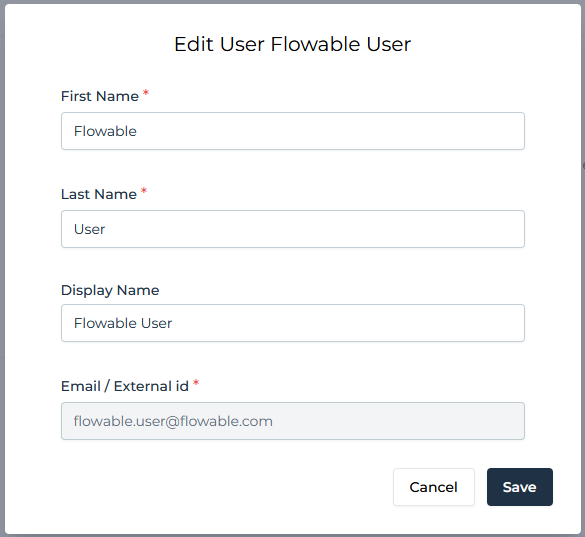
User Details
Clicking on a user record opens a detailed User Profile view, giving you full visibility into the user's identity and their access across applications. From this screen, you can easily edit user details, adjust roles, or remove access.
You’ll also see which applications the user has access to, making it simple to manage permissions and ensure alignment with their responsibilities.
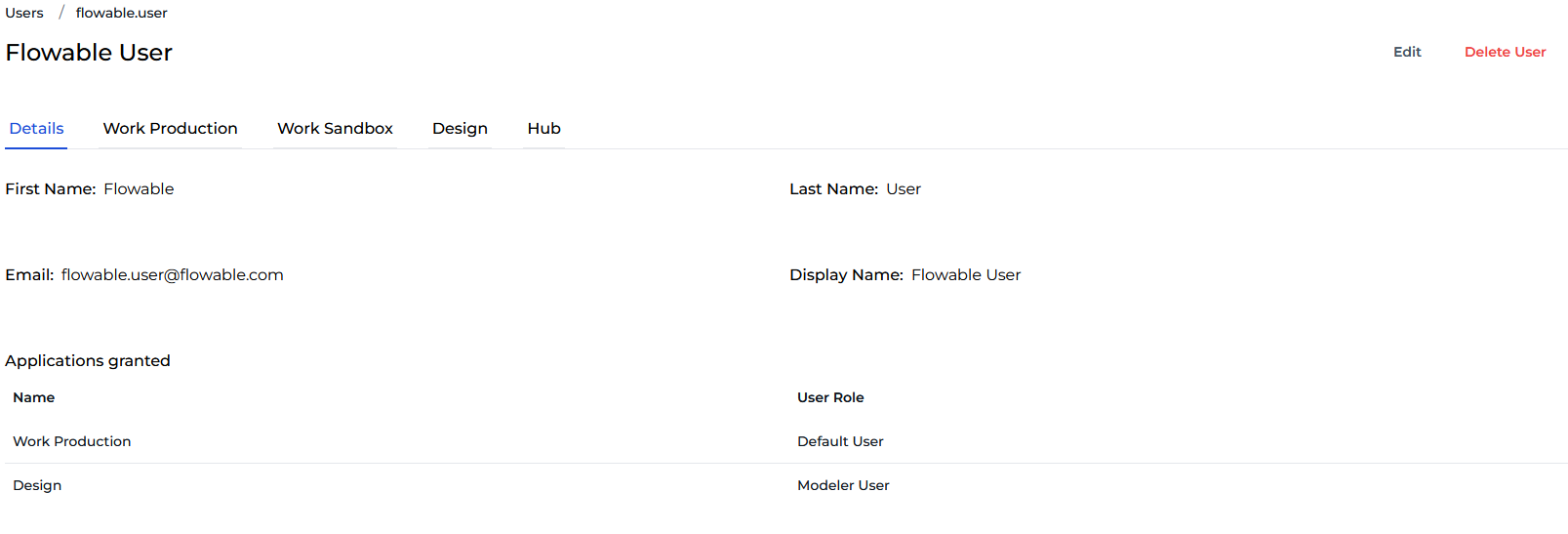
Managing Application Access
Flowable Hub gives you precise control over user access across different applications. From the User Profile screen, select the relevant application tab — Work, Design, or Hub — and you’ll unlock a set of options to manage:
- User roles
- Group memberships
- Assigned privileges
This interface allows tailor access based on responsibilities, ensuring users have exactly the permissions they need.
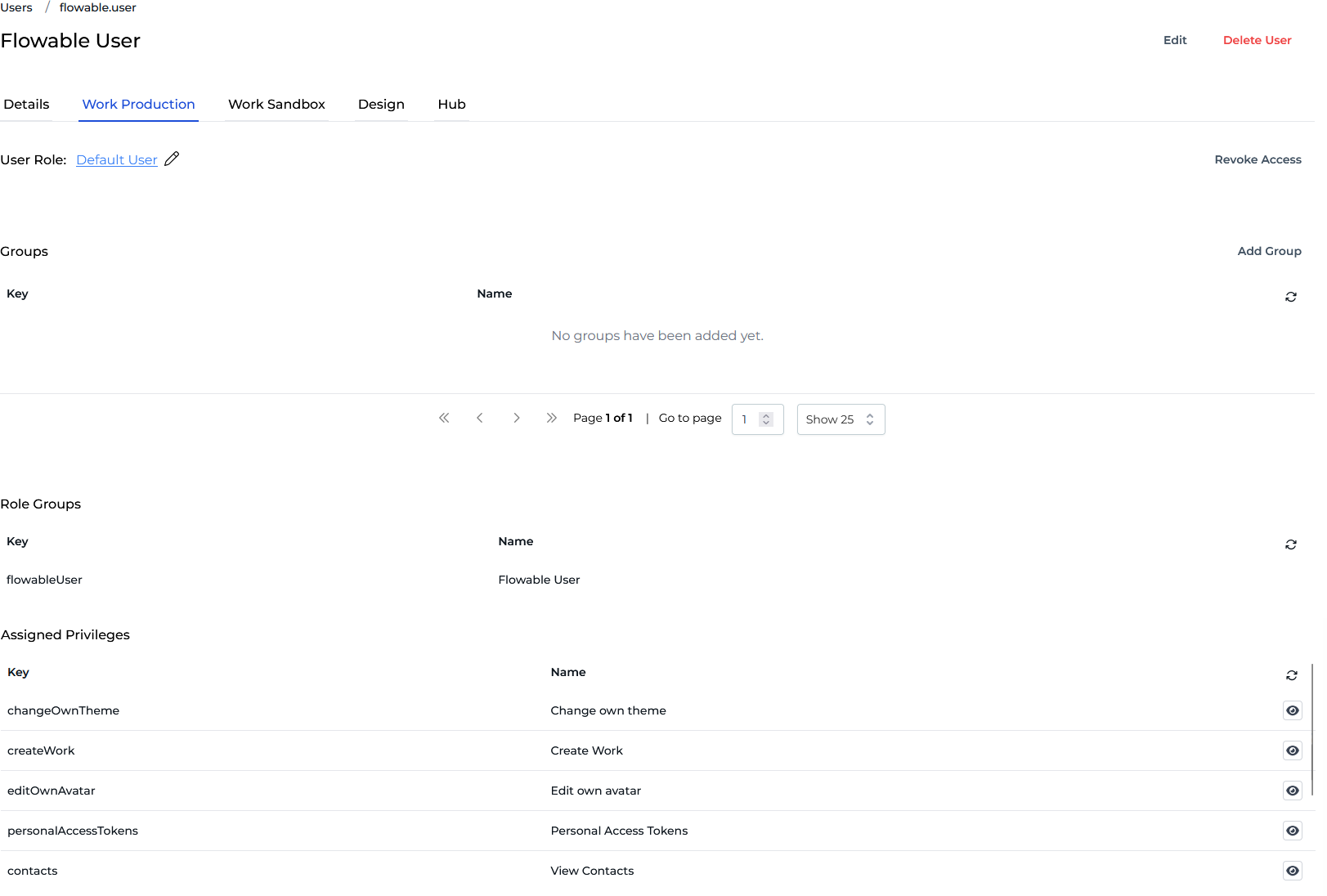
User Roles
The User Roles section provides a view of all roles available within Flowable Hub. These roles define what users can do across different applications and can be assigned during user creation or updated later as responsibilities evolve.

To see which users are assigned to a specific role within an application, simply click on the role in the User Roles section. Each application — Work, Design, and Hub — has its own tab, allowing to review role assignments across environments.
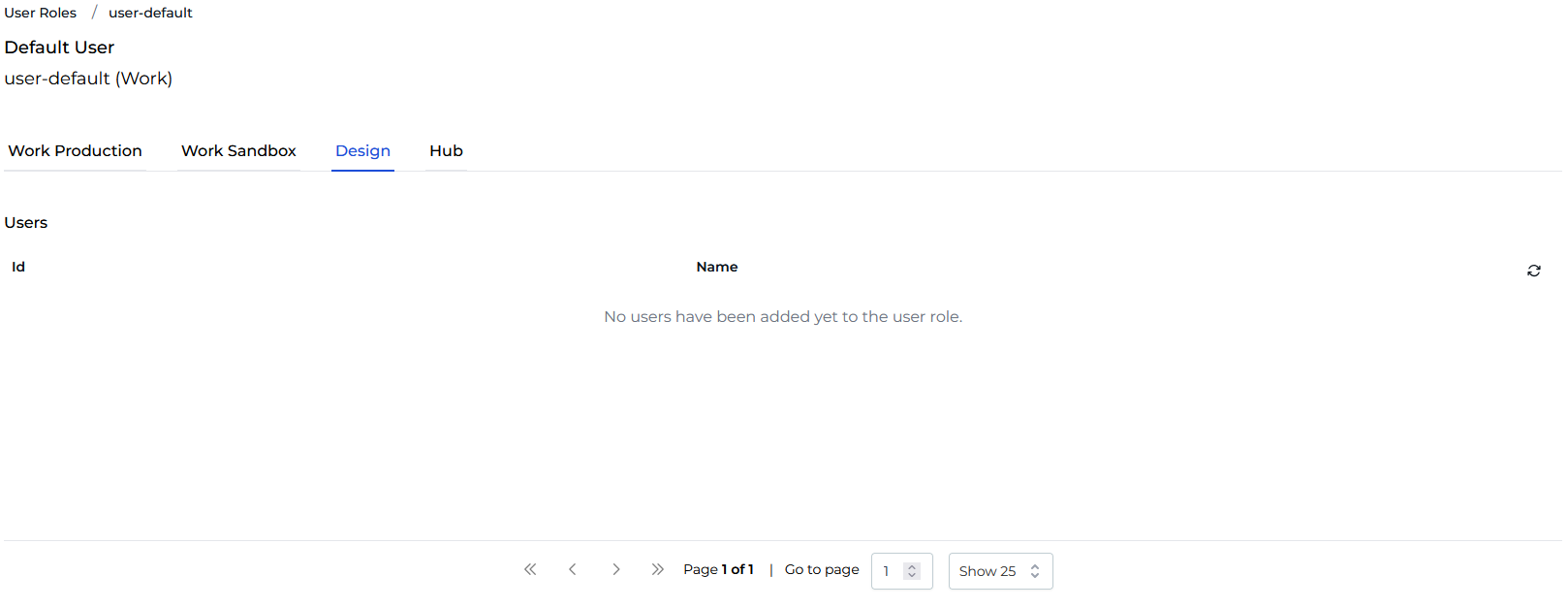
Groups
With groups, users can be organized to streamline permission management. Through the Group menu, you can create, edit, or remove groups to reflect team structures and operational needs.
Each group is defined by a Name, Group Key, and Group Type.
Filtering
At the top of the Group Management screen, you’ll find a filter bar that lets you quickly search by group name—helping you locate and manage specific groups quickly.
This feature is especially useful in complex environments where multiple teams or roles are organized into distinct groups.
A list of groups will be found underneath the filter.

Create Group
To create a new group, click the Create Group button located to the right of the filtering bar.
This action opens a form where you can define the group’s Name, Group Key, and Group Type—giving control over how users are organized and how permissions are applied across your environment.
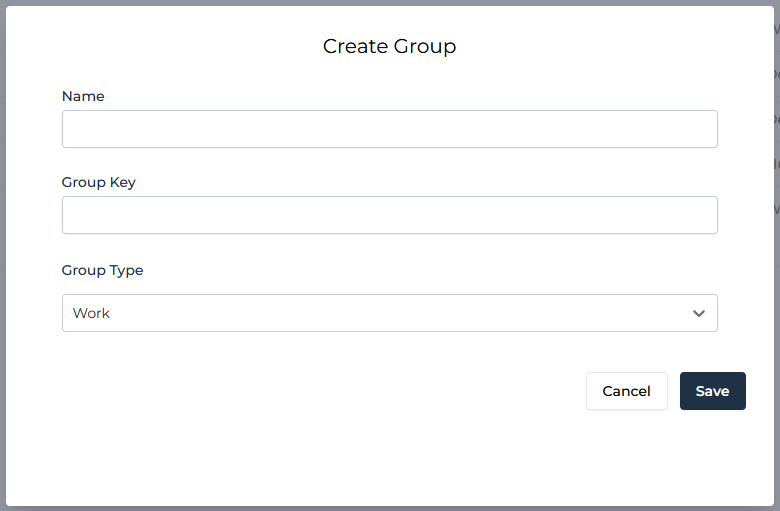
Edit/Delete Group Profile
From the Group list, you can easily edit or delete any group using the dropdown menu located to the right of each entry.

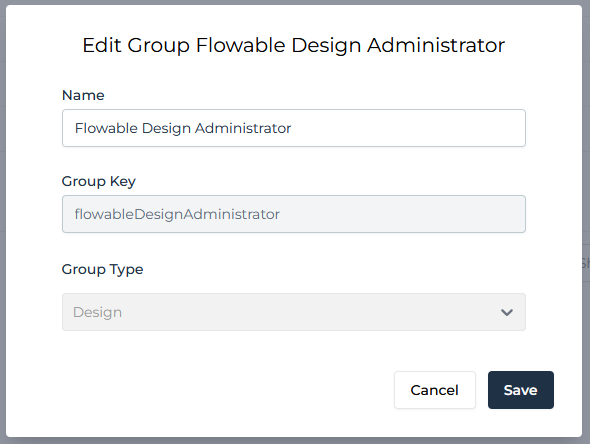
Group Details
Clicking on a group entry opens the Group Profile view, where you can see all the privileges assigned to that group. From this screen, you can also edit group details or delete the group entirely.
This view allows to check group permissions and adjust access as team roles evolve.

To see which users belong to a specific group, navigate to the application tab relevant to your review — Work, Design, or Hub. Each tab displays the group’s members within that context, making it easy to understand how access is structured across different parts of the platform.
Privileges in Hub
Flowable Hub offers a flexible and granular permissions model, allowing you to tailor access based on user roles and responsibilities across the platform. Permissions are grouped into three main categories: Design, System, and Work.
Design Privileges
- Create Design Workspace: Grants the ability to create new design workspaces for modeling applications.
- Plugin Management: Allows access to manage and configure plugins within the design environment.
- Publish to Work Production: Enables publishing of applications directly to the Work Production environment.
System Privileges
- Actuator Endpoints: Provides access to system-level actuator endpoints for monitoring and diagnostics.
- Admin: Grants full administrative rights across the platform.
Work Privileges
- Change Own Theme: Allows users to personalize their interface by changing their theme.
- Create Work: Enables access to the “Create Work” functionality within the Work application.
- Disable Data Table Filters: Controls whether data table filters are enabled or disabled for the user.
- Edit Own Avatar: Lets users update their profile avatar.
- Personal Access Tokens: Grants permission to generate personal access tokens for API authentication.
Assigning Privileges
To assign privileges to a group, click the “Assign Privileges” button from the Group Profile screen.
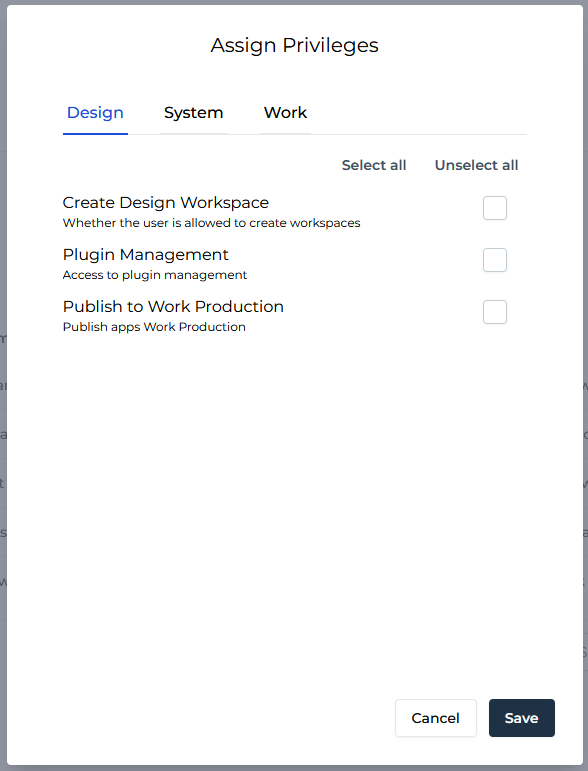
Deleting Privileges
To remove a privilege from a group, click the trashcan icon next to the privilege in the list.

Environment
The Environment section gives you sinsight and control over the live runtime artifacts of your Flowable setup.
Apps
In Flowable, applications are deployed directly to the runtime environment. The Apps page offers real-time view of all deployed applications, giving you insight into what’s running across your environment.
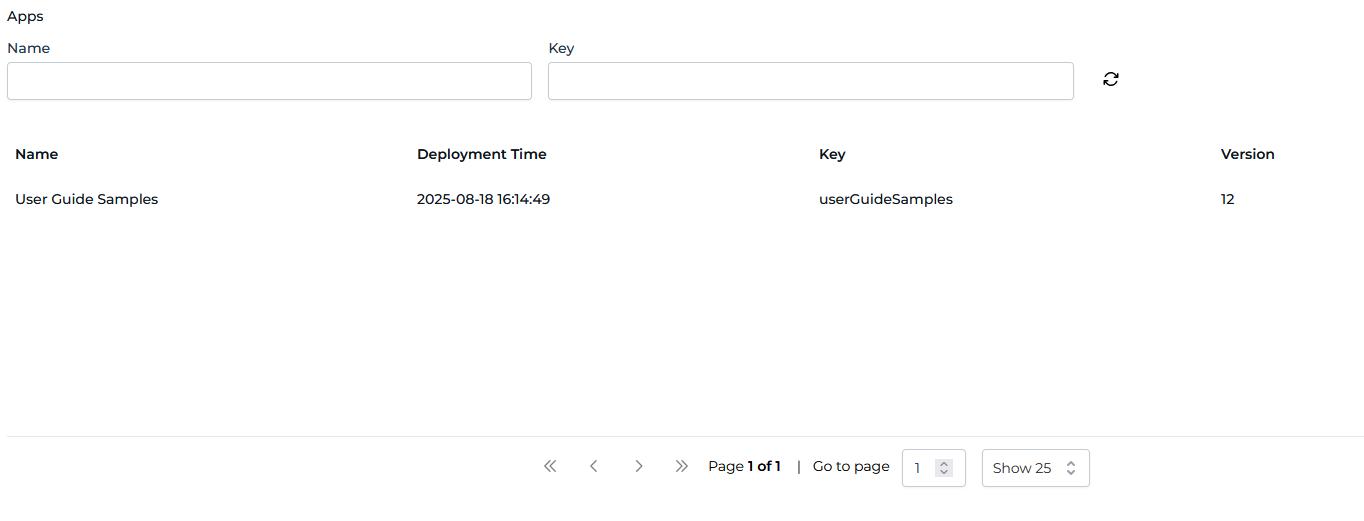
Work
Each application is powered by a set of models that are transformed into definitions at runtime. Fro these definitions, the execution engine start new instances. The Work section of Flowable Hub gives visibility and control over these definitions and their corresponding instances.
Work Instances
The Work Instances view offers a real-time snapshot of all active process and case instances running in the environment. Process and case definitions are differentiatied using icons and ID prefixes (PRC for process, CAS for case). To see more details, click on the entry.
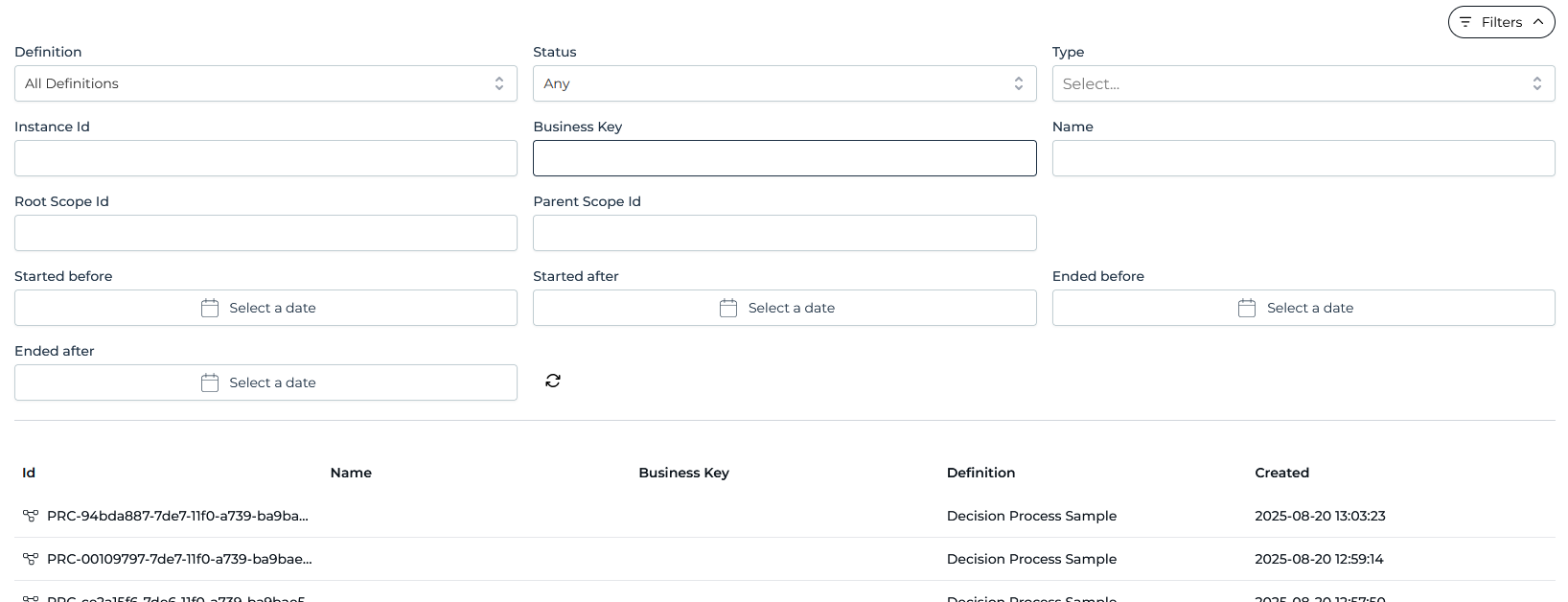
Instance Management
Instance Management in Flowable Hub gives you operational control over every running and completed instance, whether BPMN or CMMN. Active instances offer a rich set of actions—from suspending and migrating to inspecting variables and tasks—allowing to intervene and optimize in real time. Completed instances retain essential metadata for auditing and analysis, ensuring transparency across the lifecycle. With tabs for variables, tasks, subprocesses, jobs, events, decisions, and more, you get a comprehensive view of each instance’s journey.
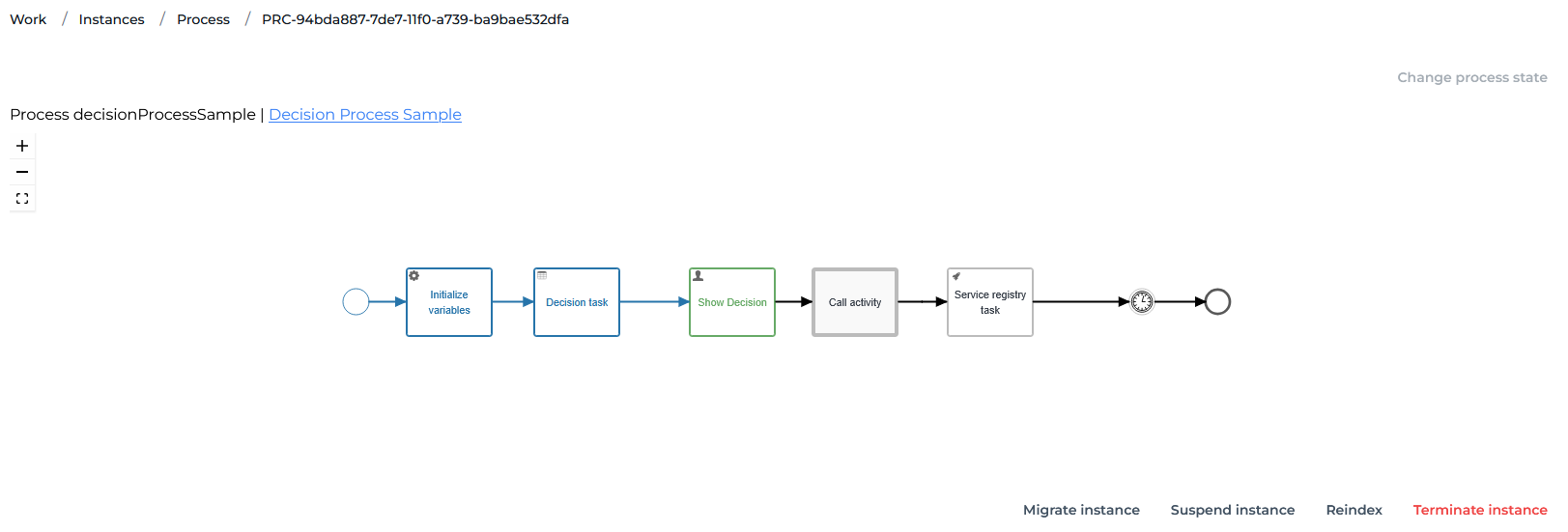
Details
The Details tab provides an overview of the instance’s metadata—including key identifiers, status, and timestamps. From here, you can also navigate directly to the associated definition, making it easy to trace execution back to its design.

Variables
The Variables tab gives you access to all runtime variables associated with the instance. The “Local Variables” toggle lets you filter for variables scoped to specific tasks, executions or plan item instances.

Tasks
The Tasks tab presents a list of all tasks associated with the selected instance. With a click, you can open any task to explore its details, manage assignments, and execute actions.

Sub Processes
The Sub Processes tab shows any nested process instance linked to the current instance. Clicking on the entry will show the details of the sub process.

Jobs
The Jobs tab displays all pending jobs associated with the instance, categorized into Executable, Timer, Suspended, Deadletter, and History.

Events
This tab shows runtime events, modeled for example with event listeners in CMMN or intermediate catch events in BPMN currently associated with the instance.

Decisions
The Decisions tab showcases all decision logic executed during the instance. Click into any decision to view its details and outcomes.

Execution
Get a granular view of the instance’s execution paths with the Execution tab. This detailed breakdown helps you understand what is occuring through the instance, supporting advanced troubleshooting.

Form Instances
The Form Instances tab lists all forms tied to the process. Clicking on a form opens a detailed pane, allowing you to review submitted data and ensure user interactions are captured accurately.

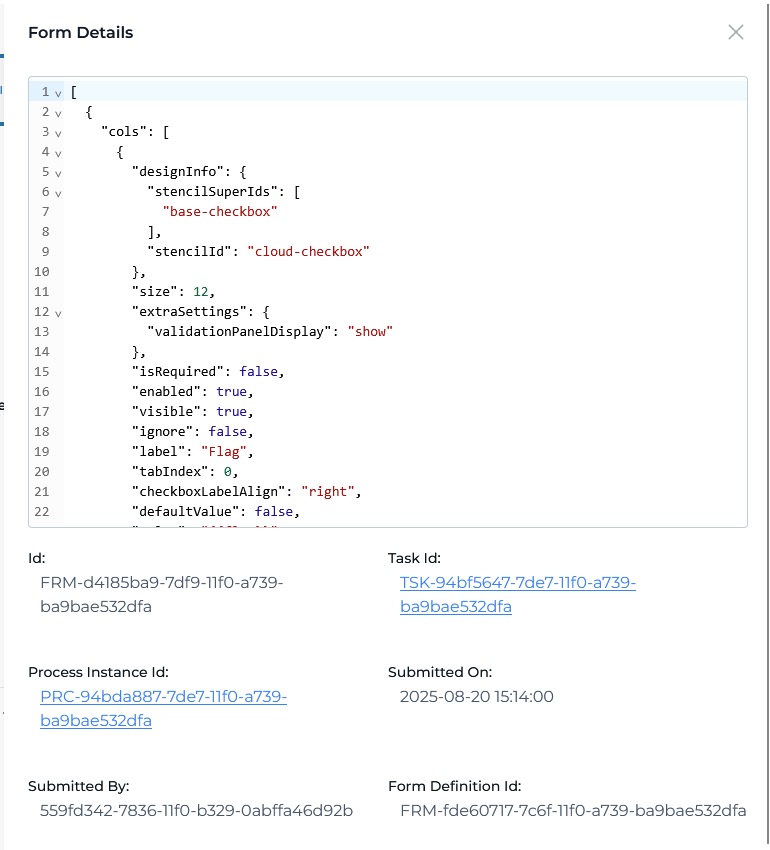
Activities
The Activities tab provides a snapshot of all runtime activities within the instance, helping you trace execution.
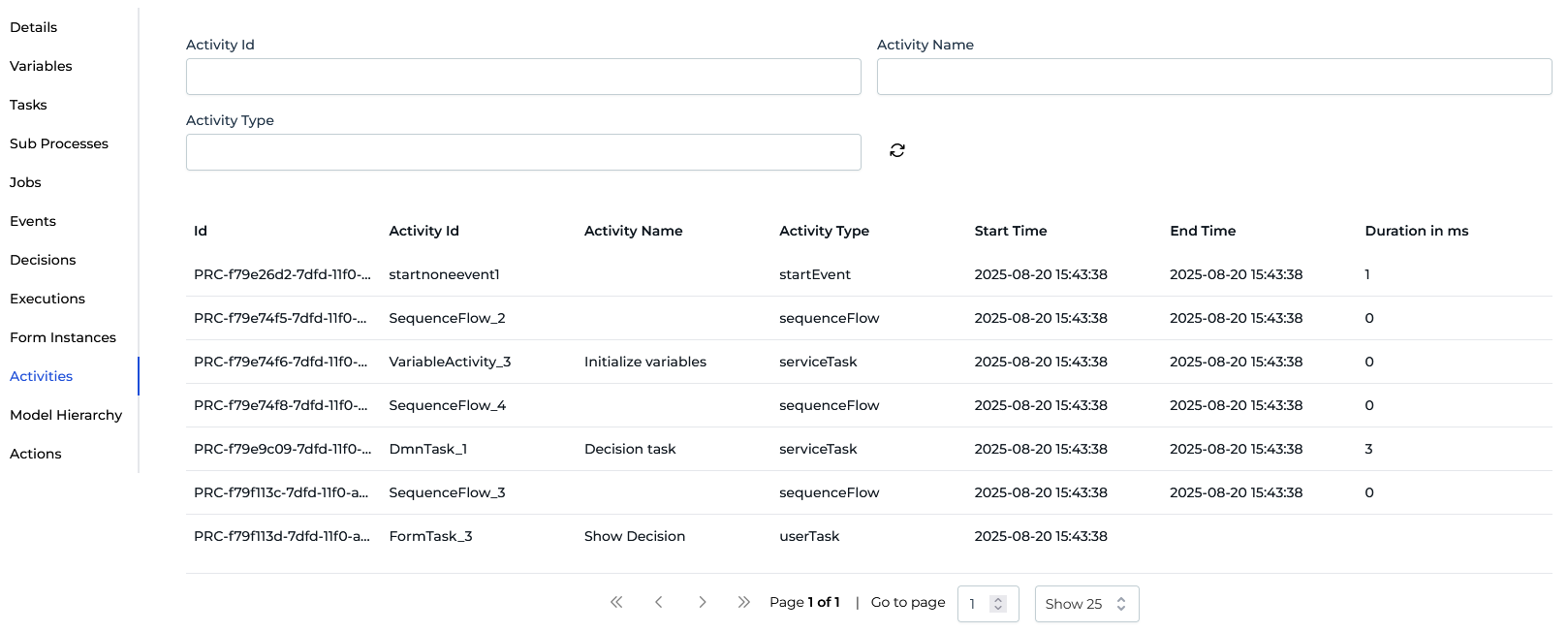
Model Hierarchy
This view outlines how the current instance fits into the broader instance hierarchy.
For example, in a case instance, it displays its child elements—such as tasks, subprocess instances, and other components—giving you full visibility into how execution is organized and nested.

Actions
The Actions tab provides a comprehensive view of all action instances that have occurred.

Work Definitions
Definitions are the blueprint behind every running instance in Flowable. Each time you deploy a model update, a new version of the definition is created—ensuring your processes evolve without disrupting operations. The Definitions tab gives an overview of all available versions within the runtime environment. By default, it highlights the latest version, but you can easily toggle to view historical revisions.
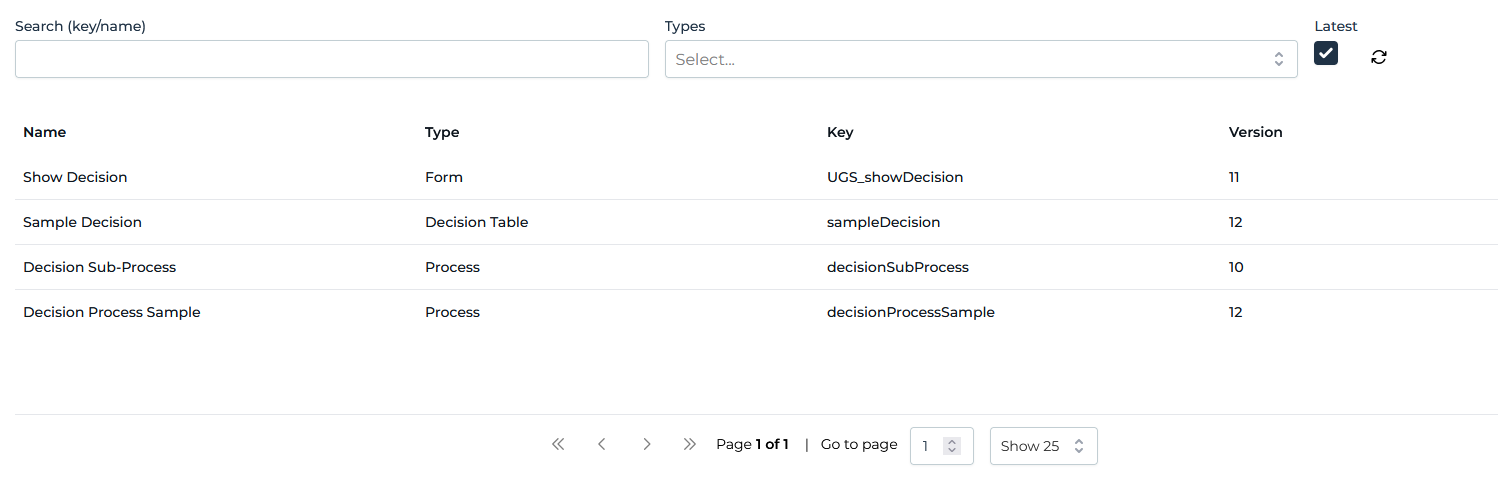
Clicking into a definition opens a detailed view where you can explore version history, inspect metadata, and trace active instances tied to that definition. Additional tabs provide access to related jobs and model hierarchy.
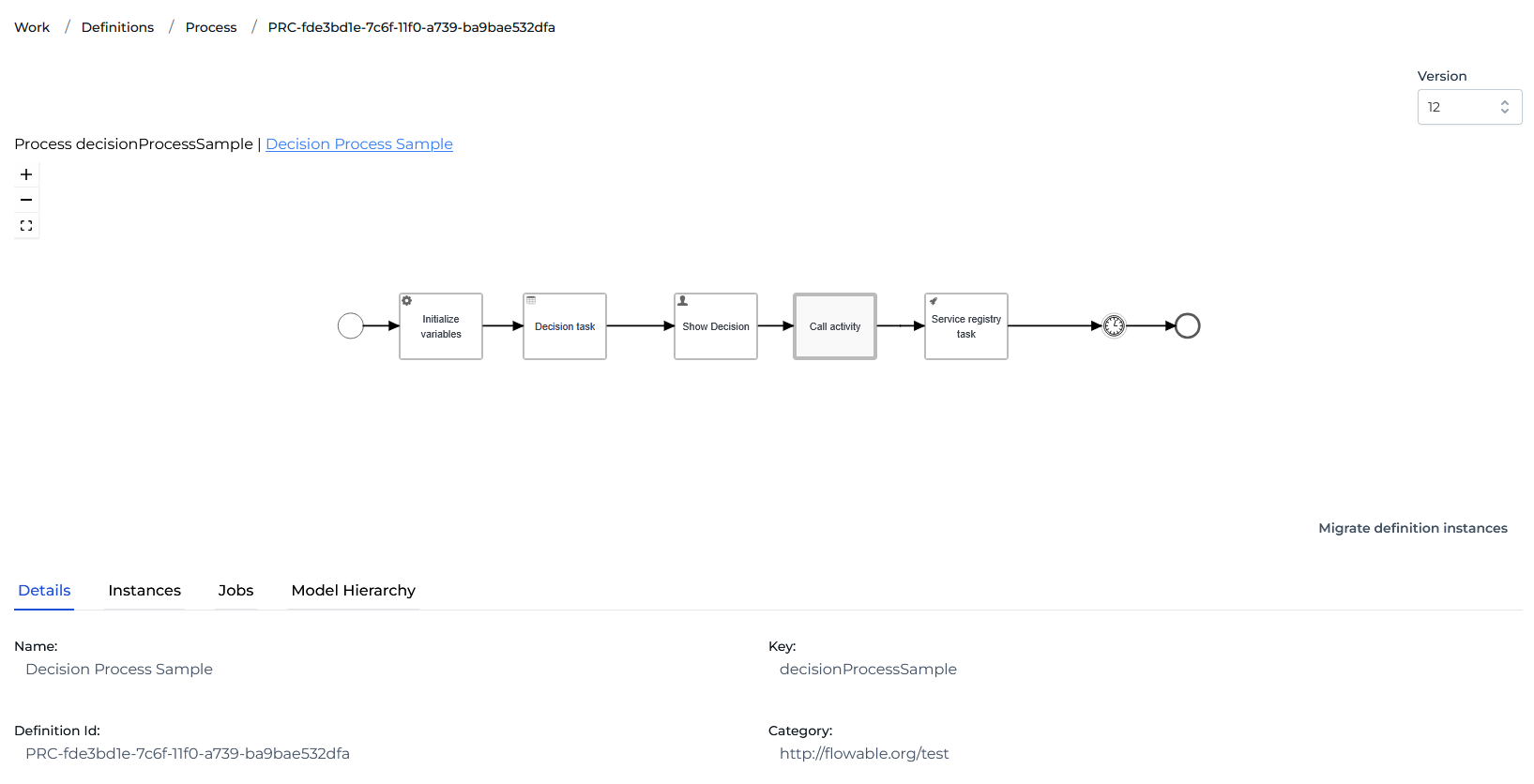
Within the definition detail view, a version selector in the top-right corner allows you to navigate between different iterations of the model—making it easy to track changes over time. The lower half of the screen features four key tabs:
Details
View essential metadata for the selected model, including versioning, deployment info, and identifiers.

Instances
Explore a list of all running and completed instances tied to the definition. Clicking an entry takes you directly to the corresponding Work Instances view for deeper inspection.

Jobs
Monitor background jobs associated with the definition, helping you stay ahead of potential execution issues.

Model Hierarchy
Visualize how the current definition fits into the broader hierarchy, including any linked subprocesses or reusable components.

Changing Process State (Token Move)
In the Instance View, you can interact directly with flow nodes within the diagram. By selecting both a source node and a destination node, the Change Process State button becomes available.
If the selected source node contains a token, that token will be moved to the destination node you chose.
- Order of selection does not matter.
- If no token is present at the selected source node, no action will occur.

Once you click Change Process State, a confirmation modal will appear.
Click Confirm to execute the token move.
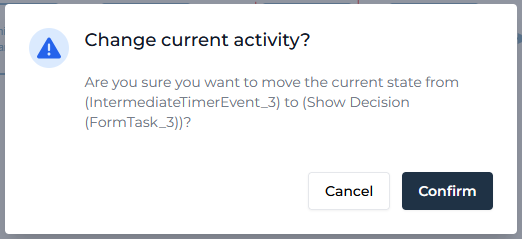
Instance Migration Walkthrough
Flowable Hub makes it easy to migrate individual instances to a new definition version—without disrupting execution. Here’s how the process works:
- Access the Instance Detail View
Navigate to Work > Instances and select the instance you want to migrate. From the detail screen, click the Migrate Instance button.
- Select Target Definition
A migration screen will appear, allowing you to choose the target definition version. You can migrate to a newer version—or even revert to an older one—depending on your needs.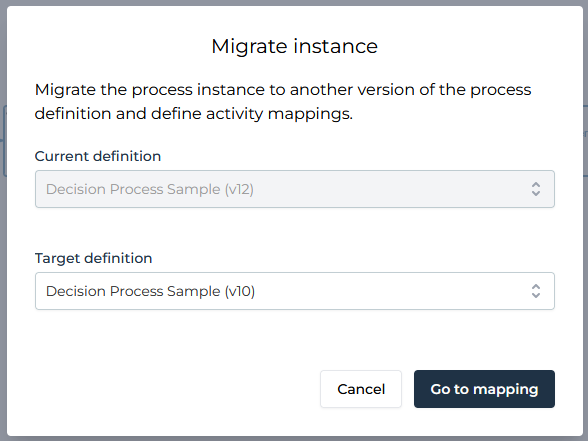
- Map Execution Steps
Click Go to Mapping to define how tokens should transition between the current and target definitions. Select a step from the left (current version) and a corresponding step from the right (target version), then click Add to Map to create the mapping.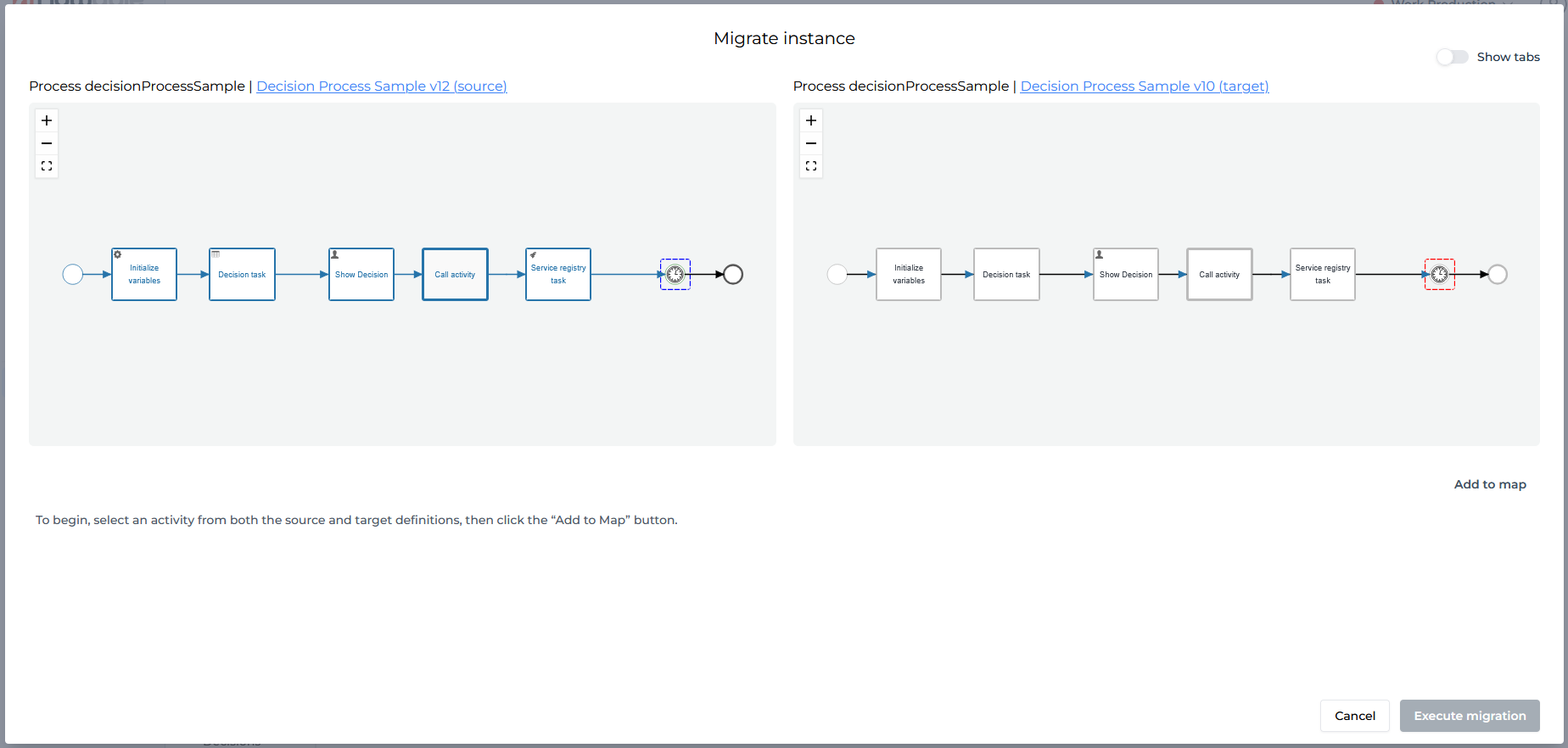
- Review and Execute
Once all necessary mappings are defined, click Execute Migration to apply the changes. Confirm in the modal that pops up and the instance will now reflect the new definition, with tokens repositioned according to your mappings.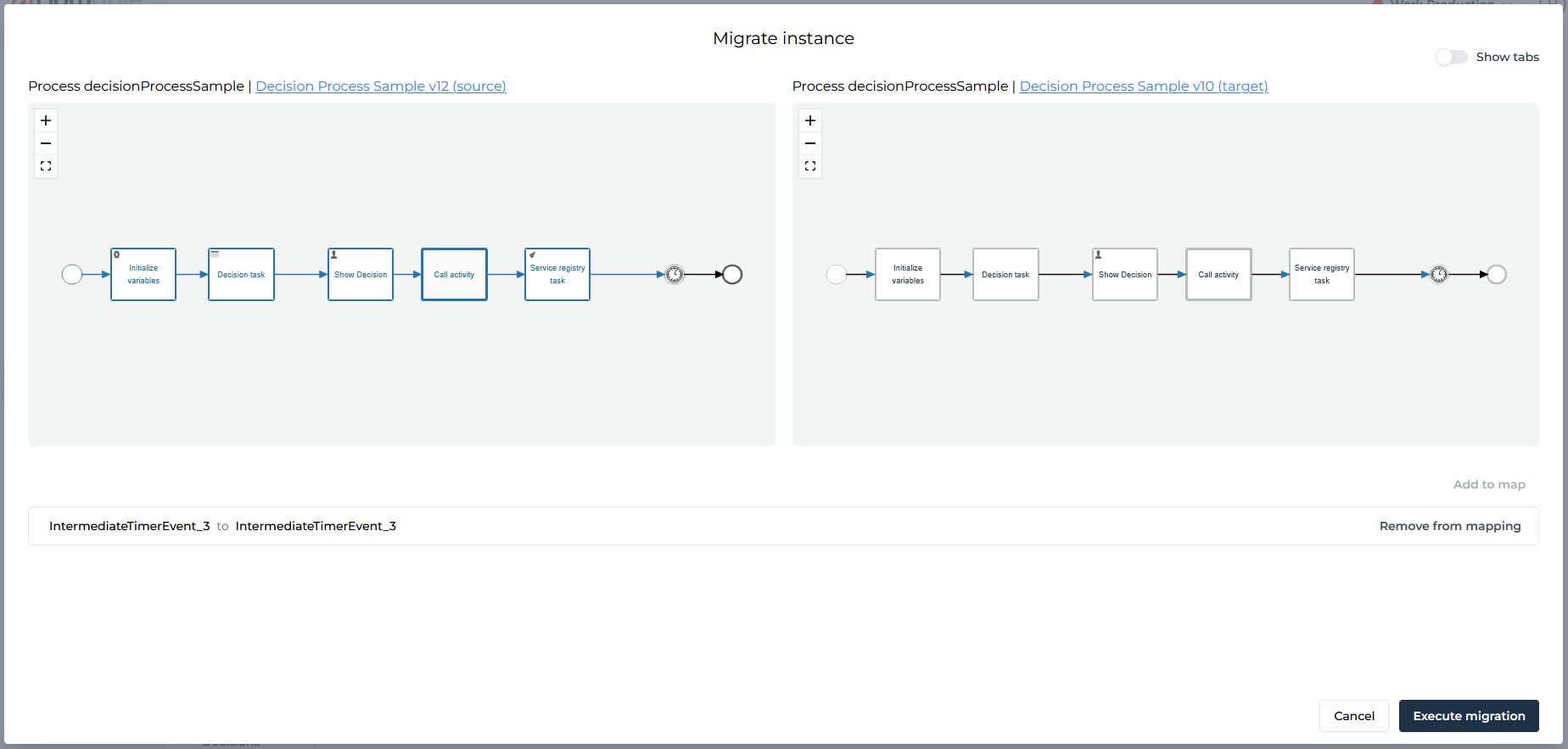
Definition Migration
In addition to migrating individual instances, Flowable Hub allows you to upgrade all instances tied to a specific definition—streamlining bulk updates across your environment.
From the Definitions screen, simply click the Migrate Definition Instances button. This launches the same migration interface used for single-instance migration, allowing you to select a target version and define token mappings.
Once mappings are confirmed, executing the migration will update all instances associated with the selected definition—ensuring consistency and reducing manual overhead. This feature is especially useful for large-scale deployments or when rolling out updates across multiple workflows.
Decisions
The Decisions tab provides a clear view of all DMN based decision logic executed within your environment.
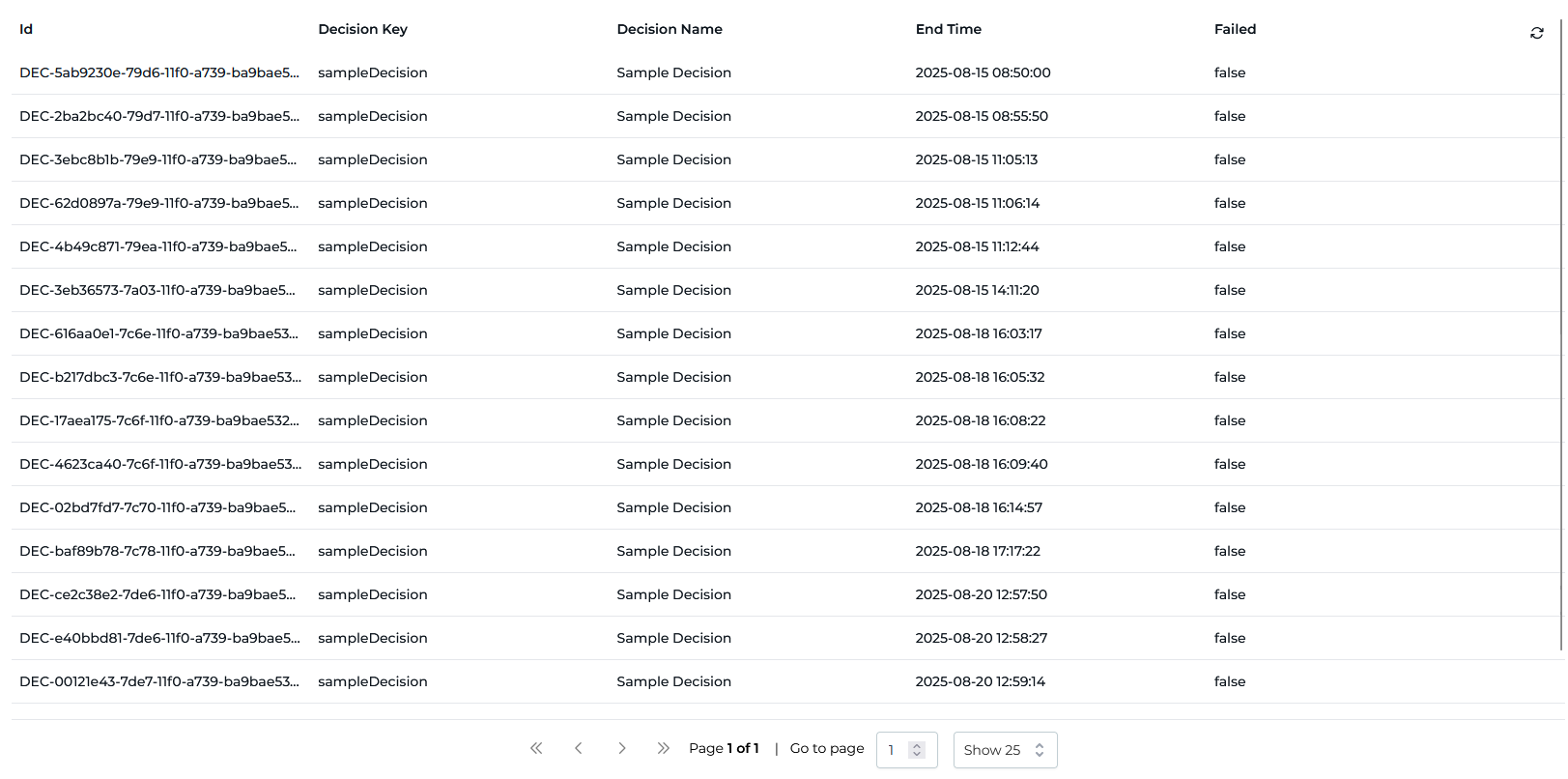
Clicking on a decision opens the details on the specific execution of the DMN execution:
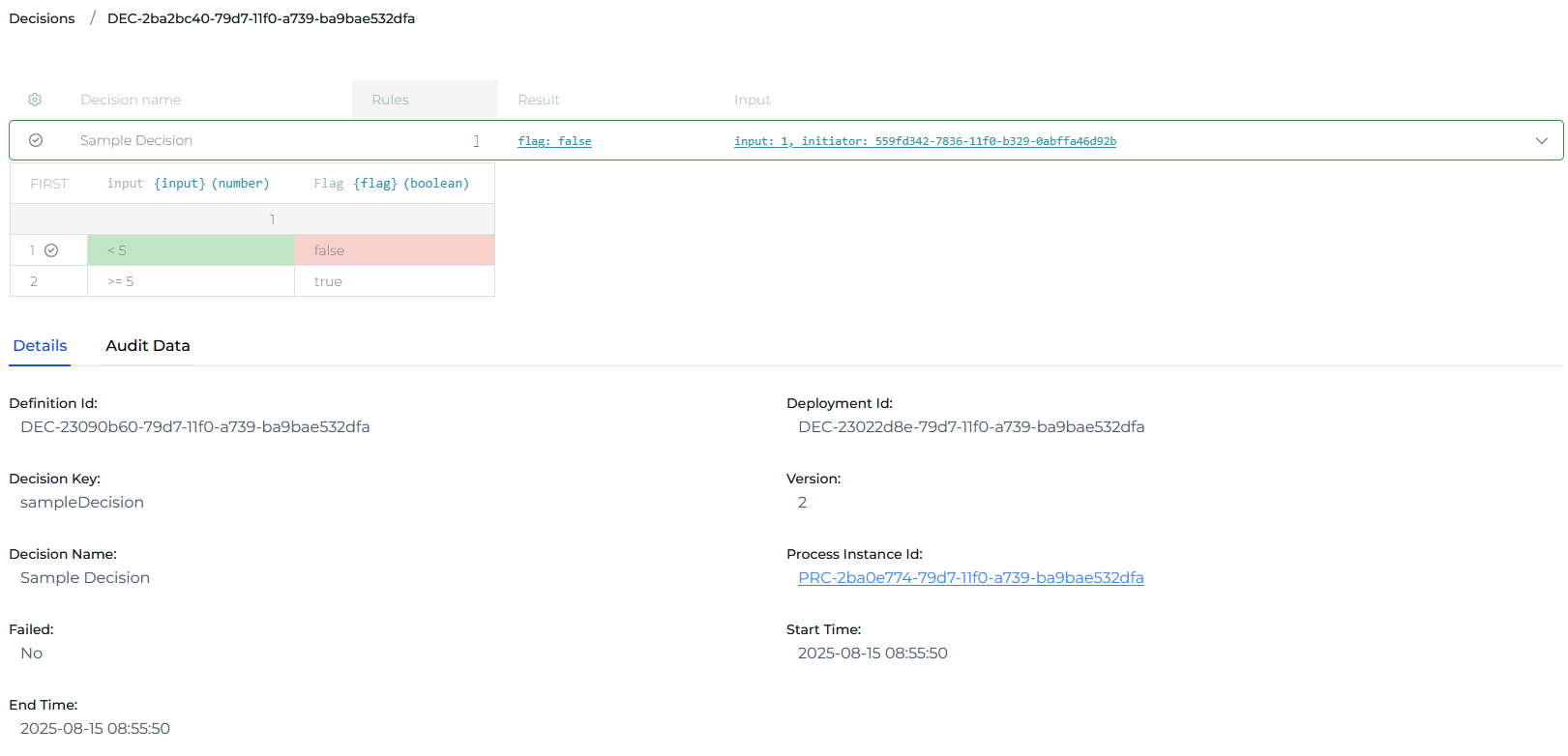
Tasks
The Tasks tab gives visibility into both active and completed tasks. Active tasks come with a set of management options—including update, assign, delegate, and complete—allowing you to take direct action when needed.
Each task includes tabs for:
- Details: View task metadata such as name, description, assignee, due date, and priority.
- Sub Tasks: See any child tasks linked to the main task.
- Identity Links: Review all users and groups associated with the task.
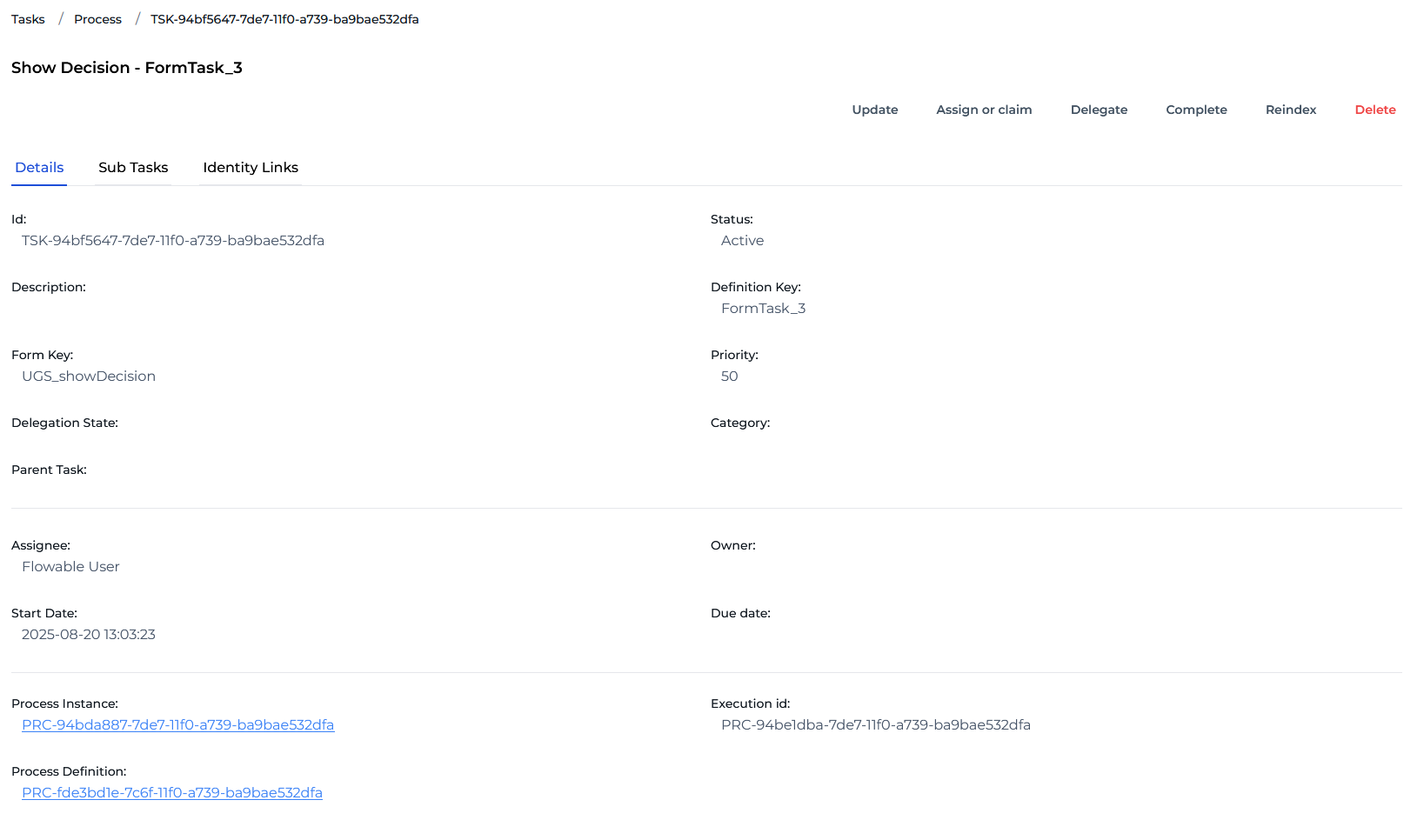
Updating Tasks
The Update button lets you modify key task details—including name, description, assignee, owner, due date, priority, and category/
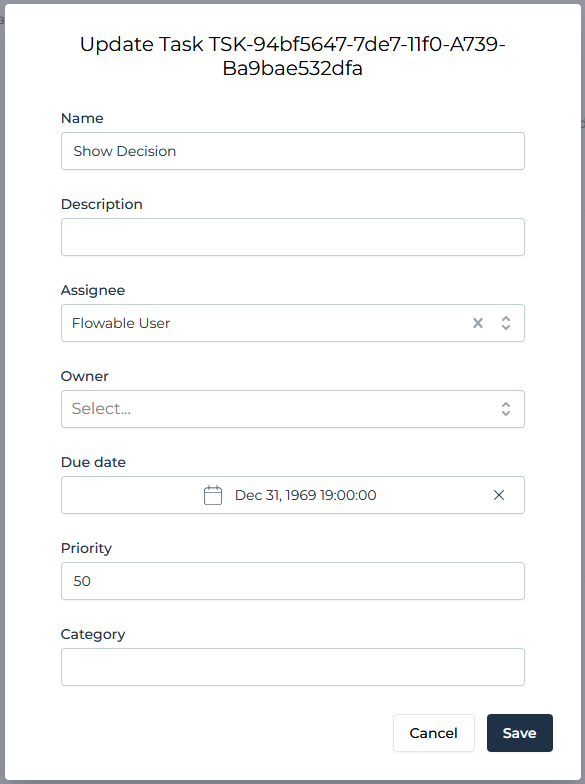
Assign / Claim Tasks
The Assign or Claim button allows users to take control of a task or assign it to another team member.
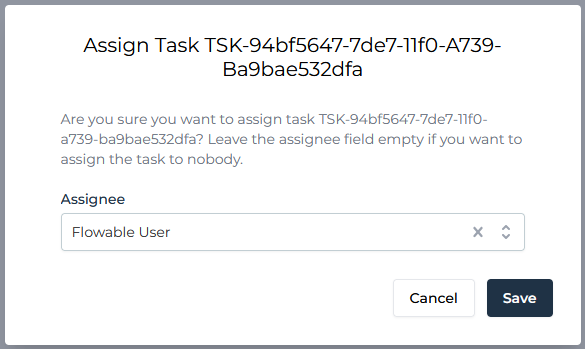
Delegate
Reassign tasks without losing visibility. Use the Delegate button to pass a task to another user while maintaining the task owner.
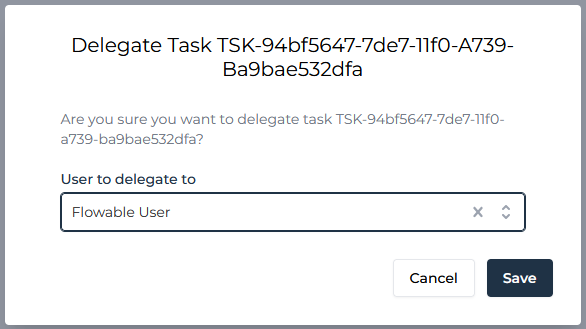
Complete
Clicking the Complete button triggers a confirmation prompt, allowing you to finalize a task once all required actions are taken.
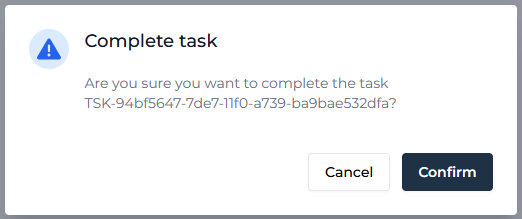
Jobs
The Jobs tab gives you a view of all asynchrounous background jobs running within your Flowable environment. Jobs are categorized into five types: Executable, Timer, Suspended, Deadletter, and History.
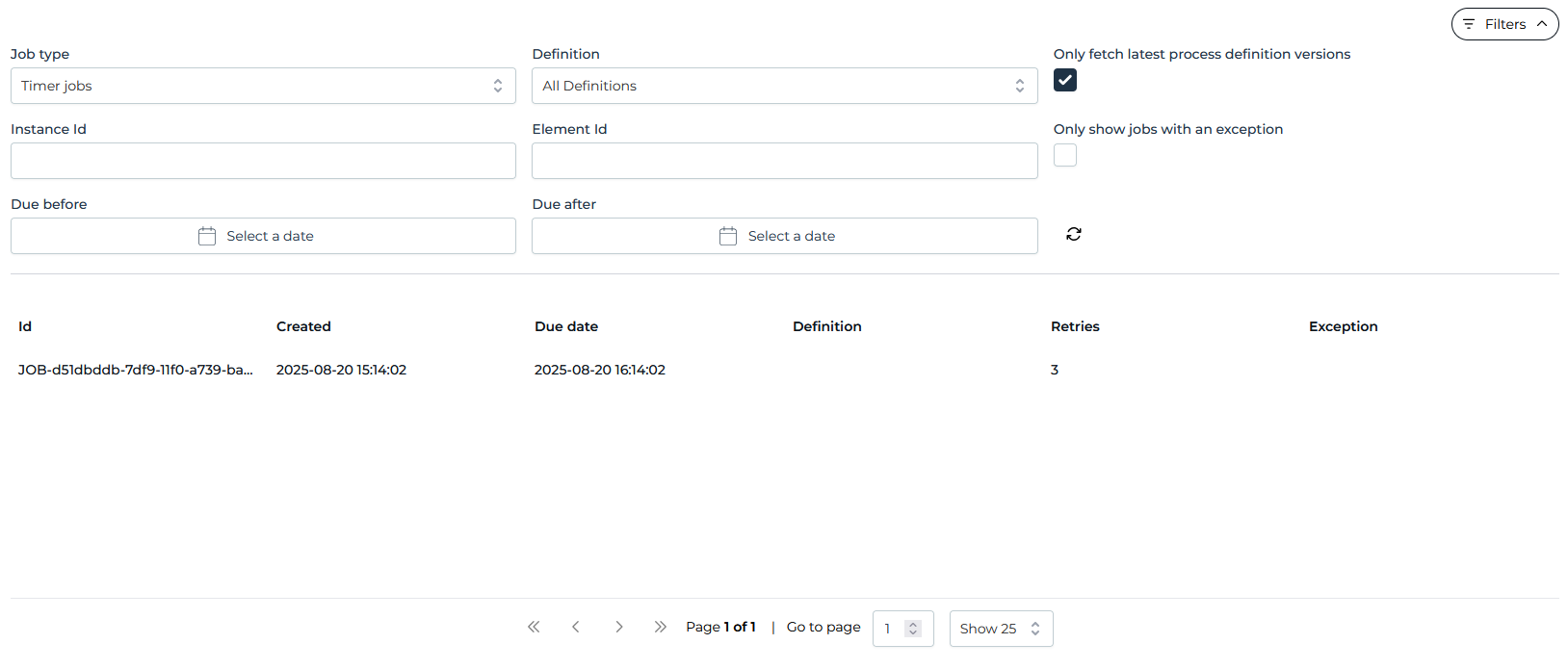
Clicking on a job entry opens a detailed view where you can explore key metadata associated with the job. This includes fields such as Due Date, Created Timestamp, Instance ID, Execution ID, Element ID and Name, Remaining Retries, Definition Reference, Lock Owner, Lock Expiration Time, and Tenant Context. You are able to move, reschedule, or delete a job from this view.
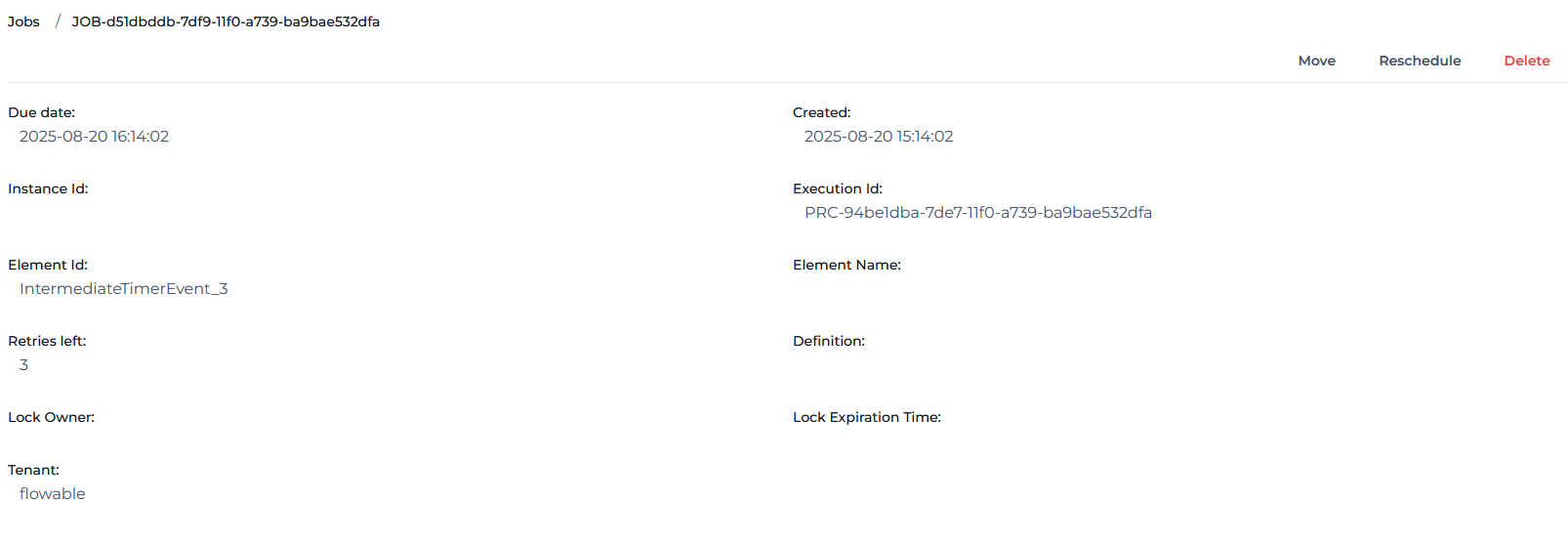
Incidents
The Incidents tab provides an overview of all execution issues across your environment. Whether it's a failed job, an unhandled exception, or a process that didn’t behave as expected, incidents are logged here for tracking and resolution.
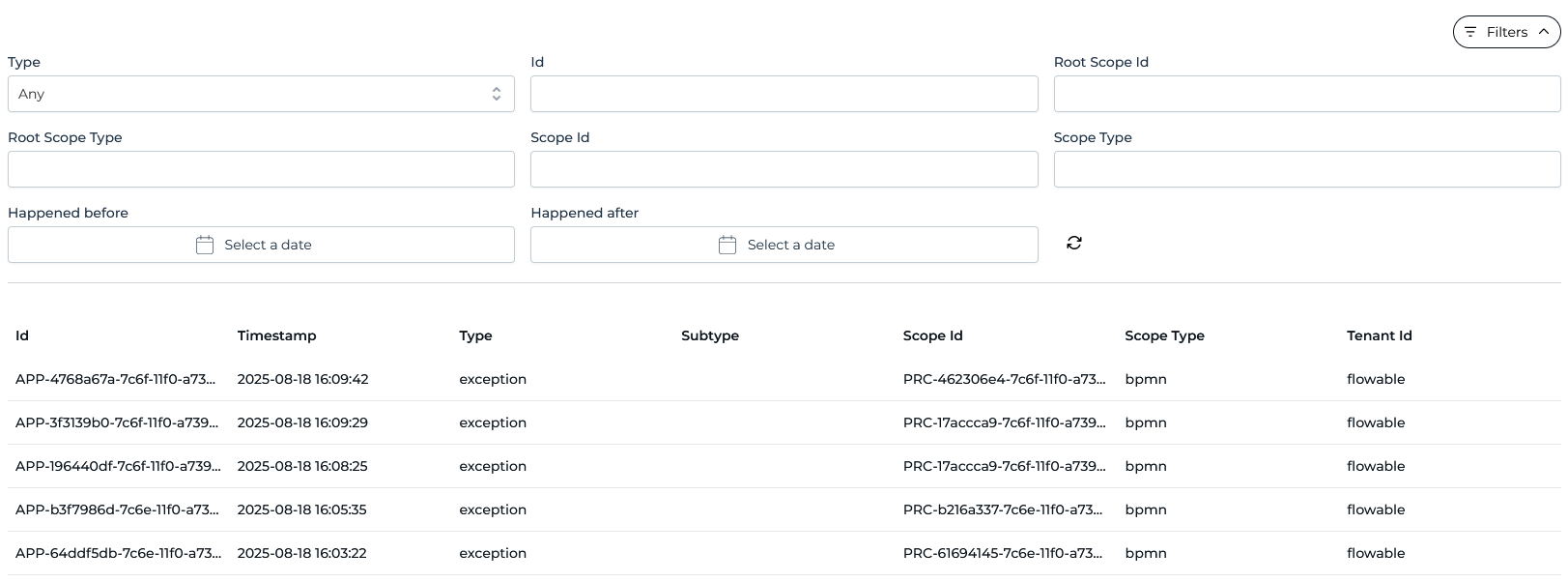
Clicking on an incident opens a detailed view, allowing you to investigate root causes, review related metadata, and take corrective action.
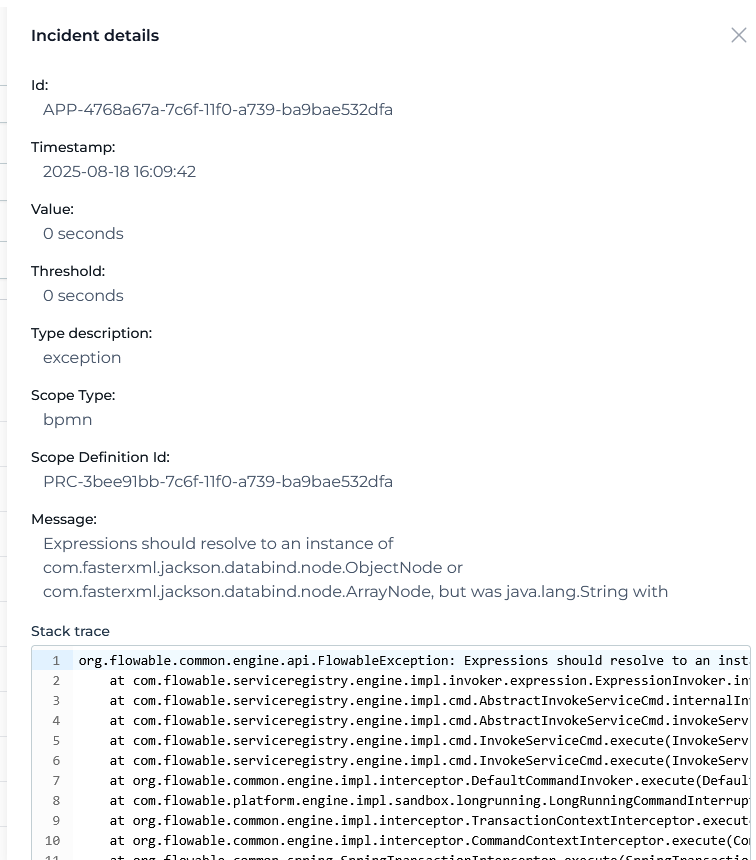
Dashboard
The Dashboard section offers various visual charts that give insight into the environment.
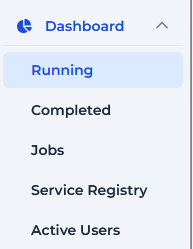
Running Instances
This chart shows the number of active instances currently being executed across the environment. It helps you monitor throughput, detect spikes in activity, and ensure your workflows are performing as expected.
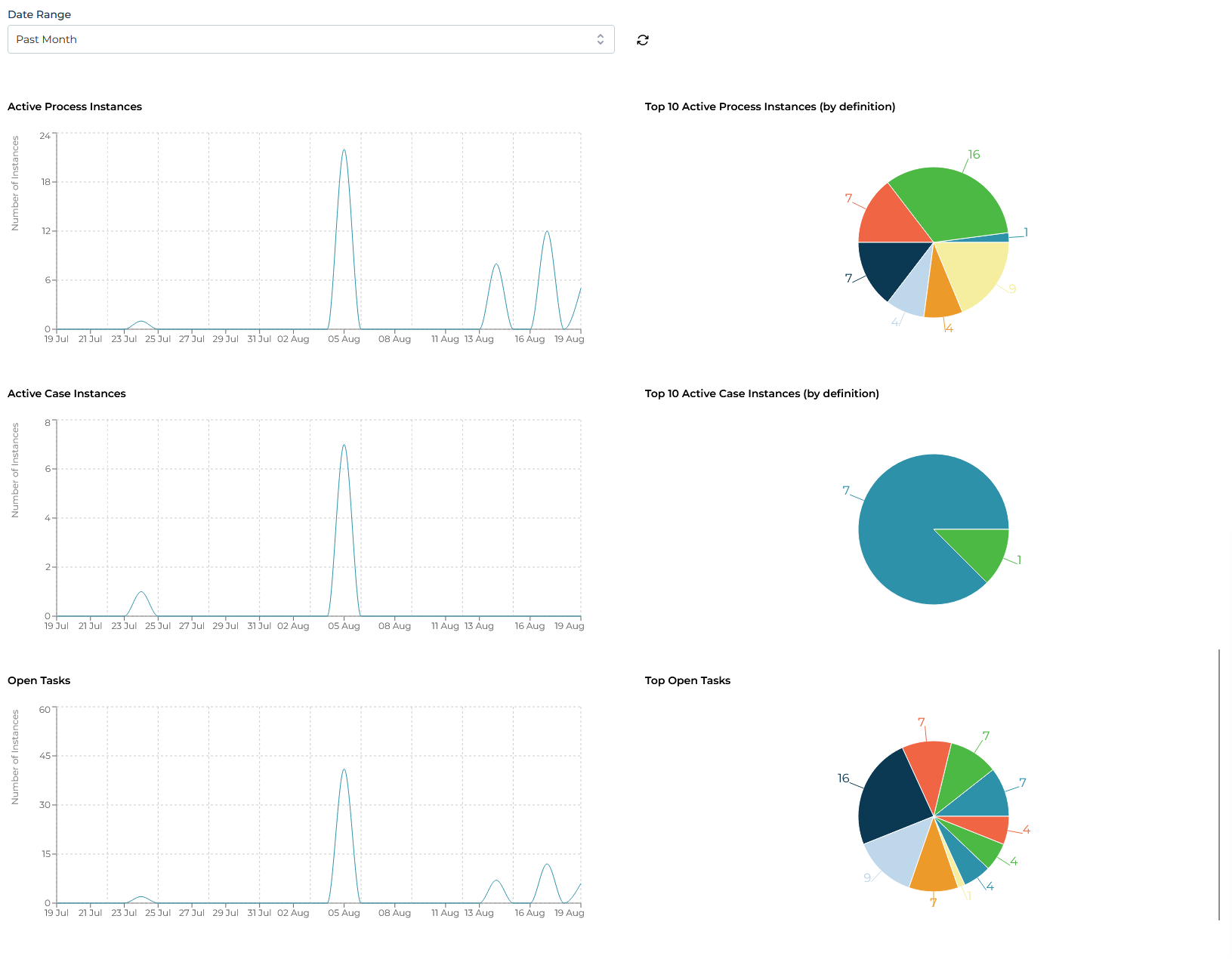
Completed Instances
This chart shows metrics around process and case instances that were completed.
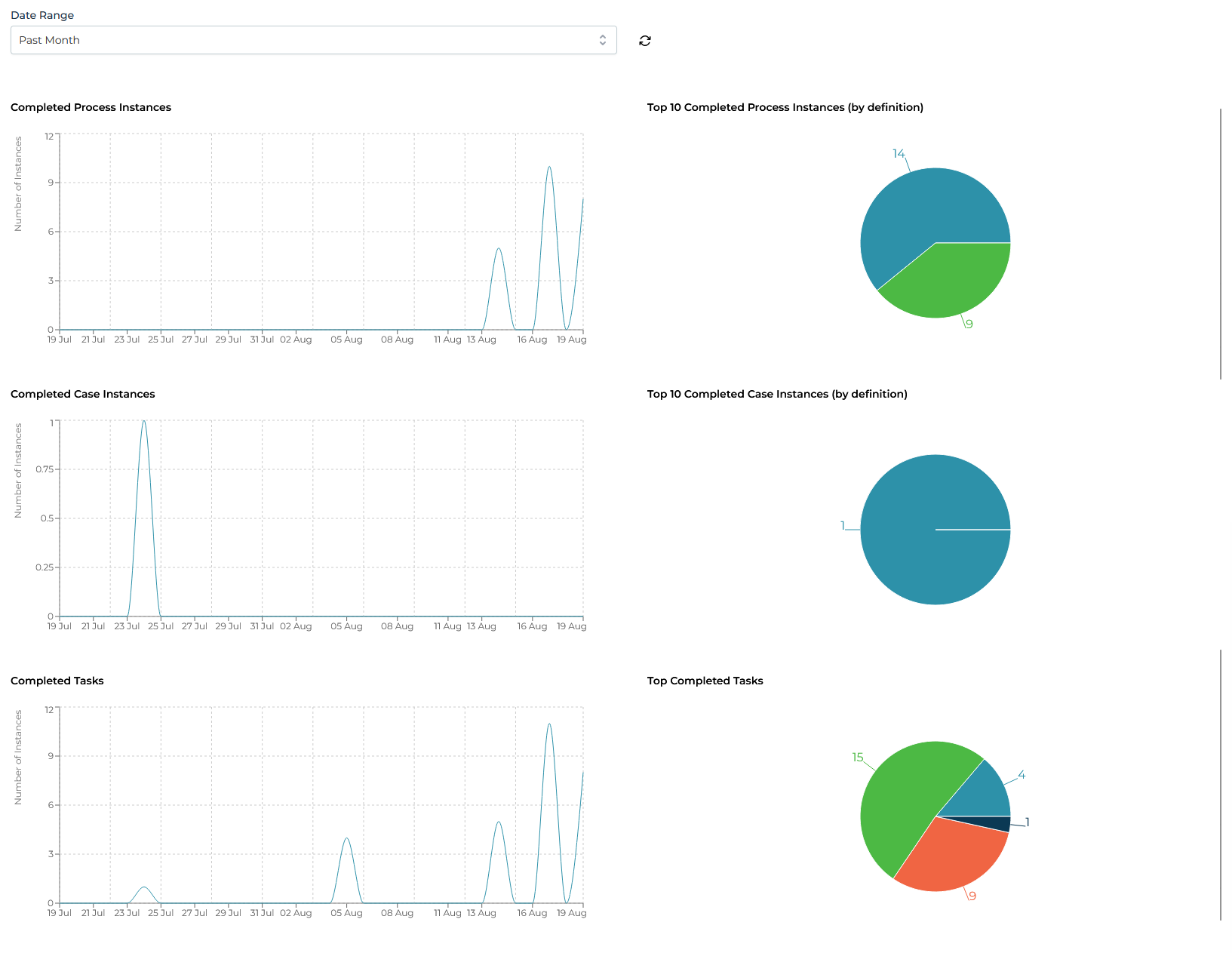
Jobs
These chart can be used to monitor background activity and system load. It displays the volume and status of jobs—such as timers, asynchronous tasks, and retries.
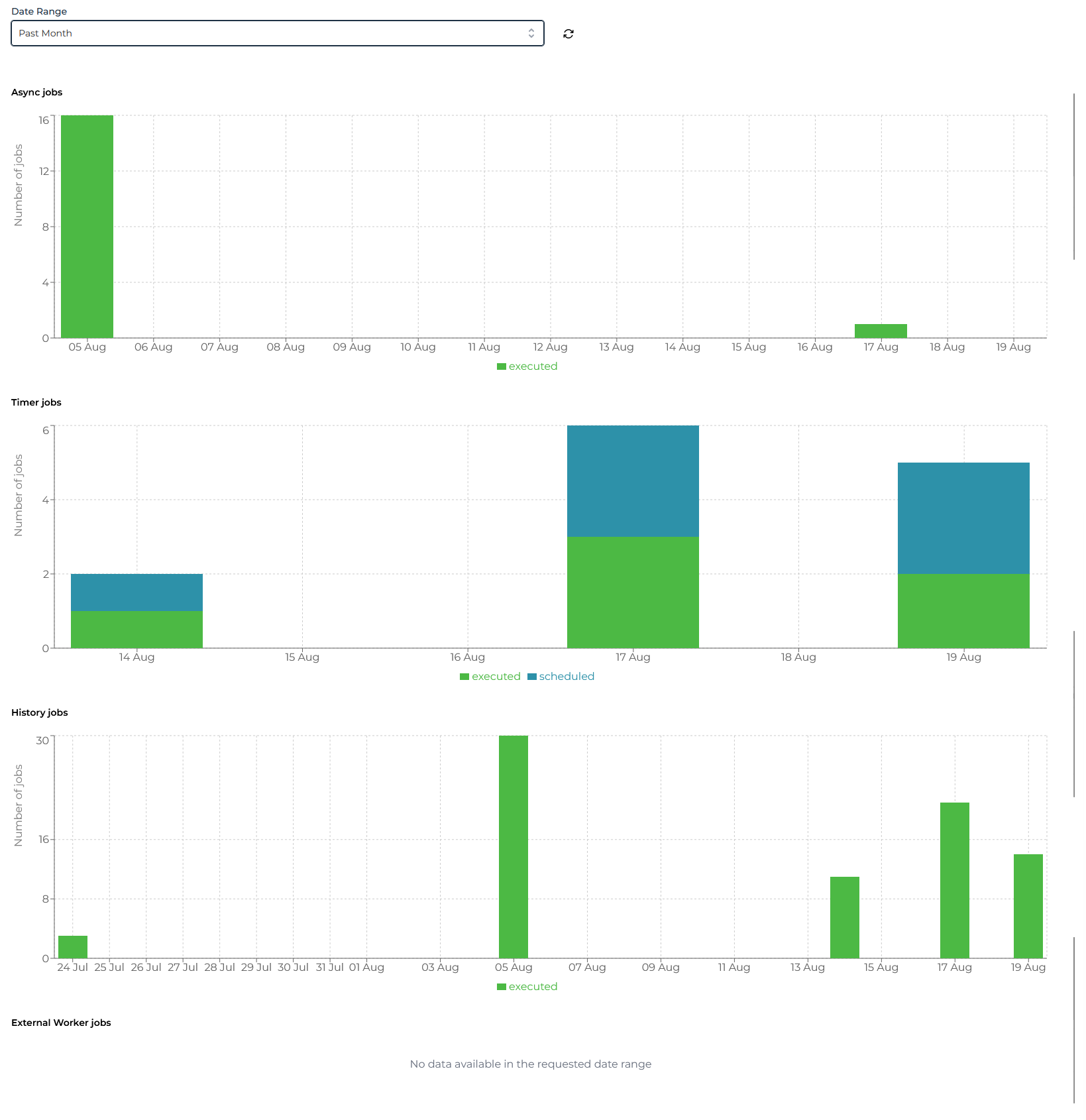
Service Registry Executions
This dashboard view highlights executions involving external services, giving insight into how external systems are being called and how frequently. It’s especially useful for tracking integration health and responsiveness.
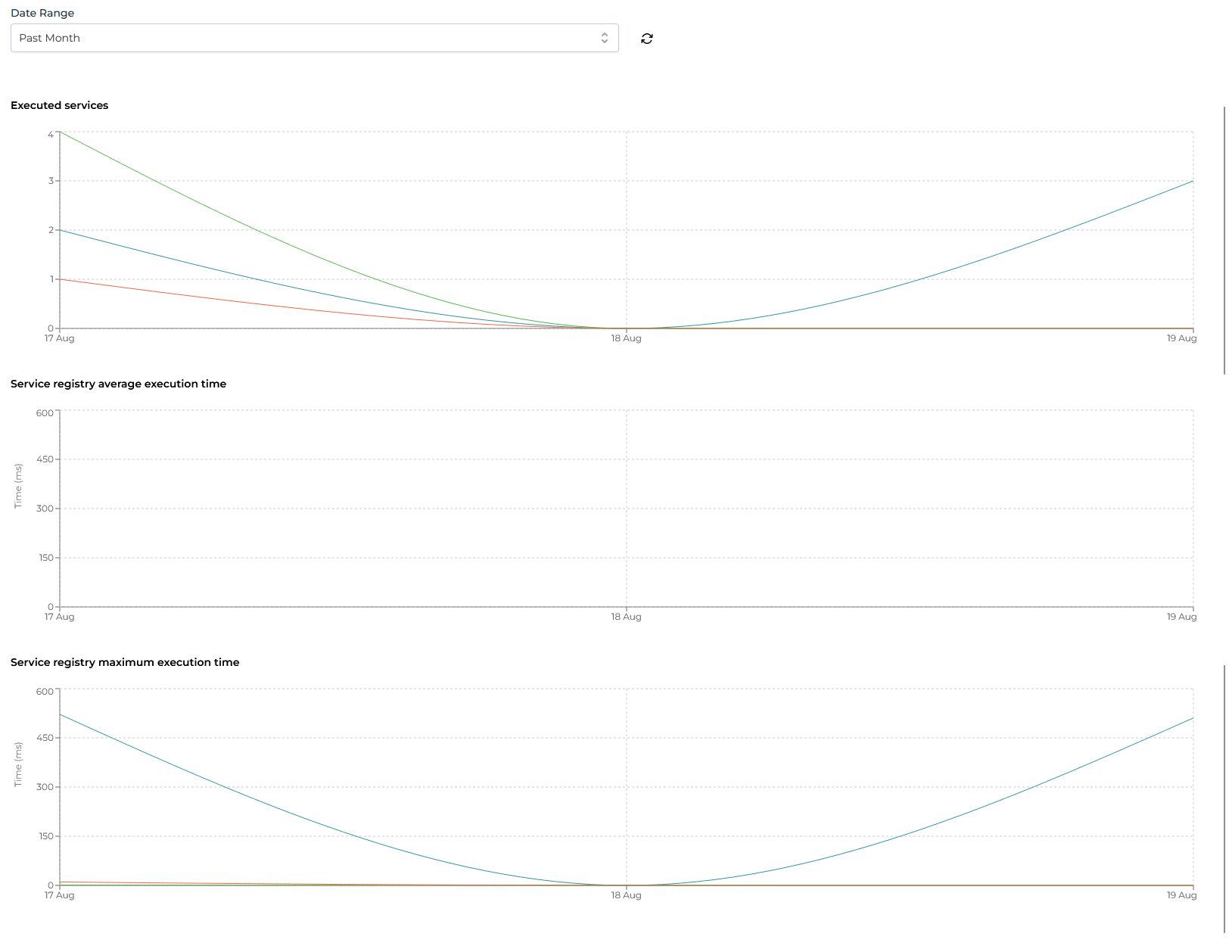
Active Users
This chart gives an overview of active users within the environment.
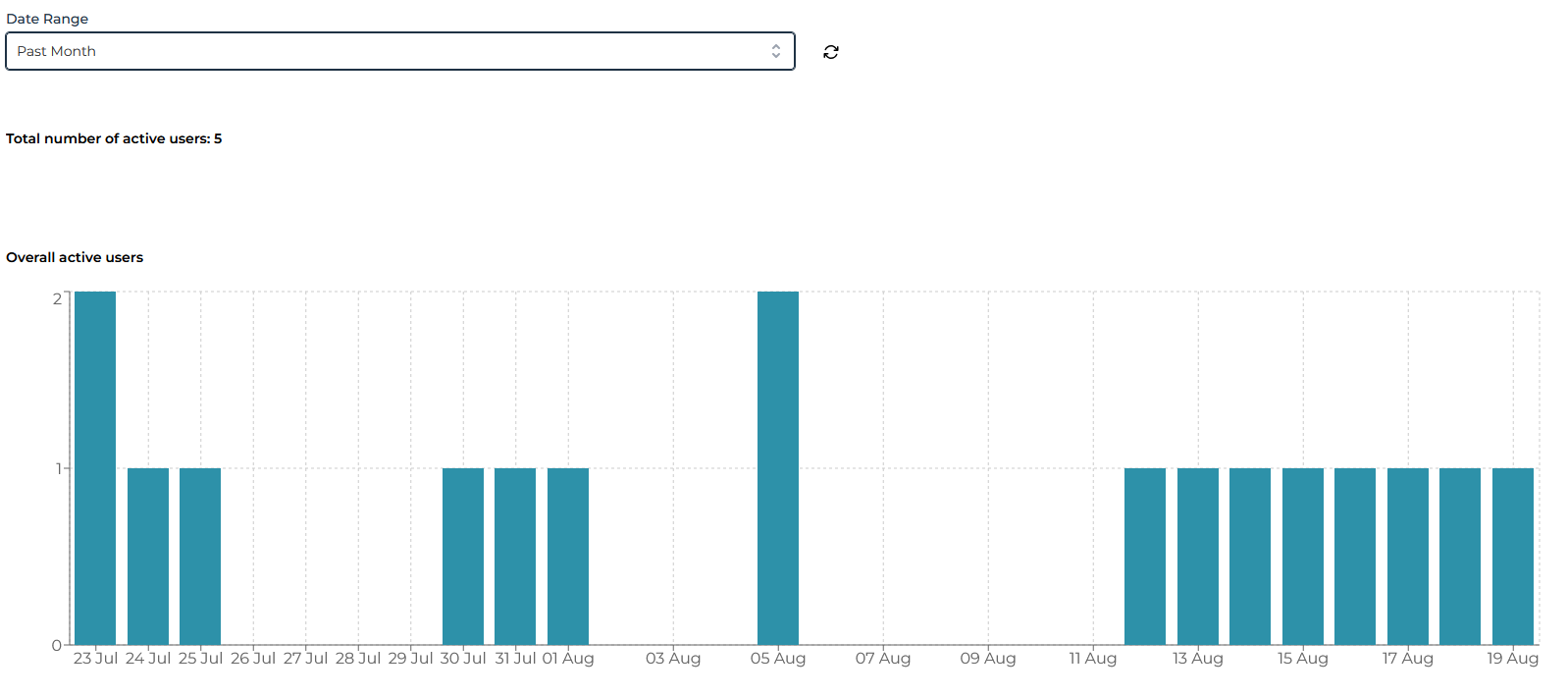
OAuth2 Clients
The OAuth2 Clients section allows you to configure trusted clients for authentication and API access. New clients can be added, scopes defined, and credentials set.

Clicking “Add OAuth2 Client” opens a guided form where you can enter client details, and configure access tokens.
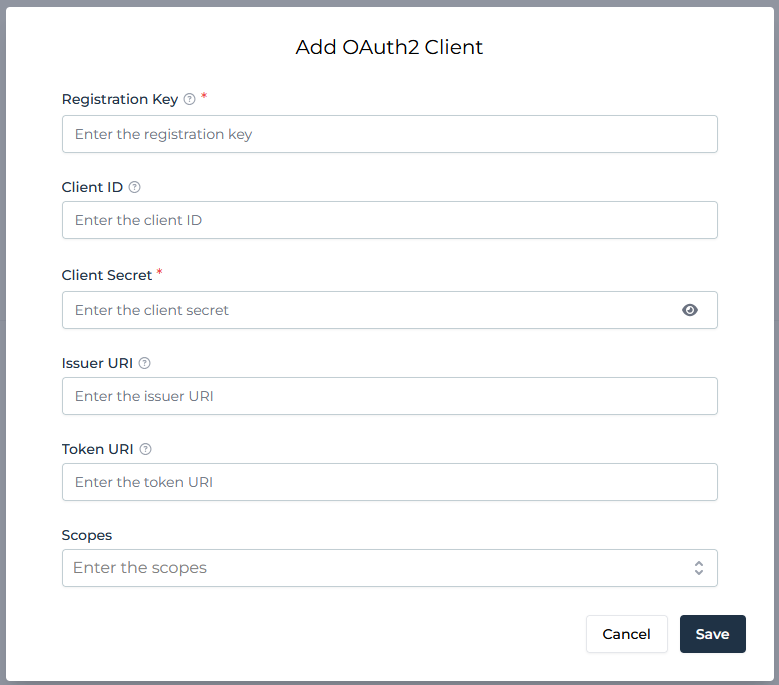
Secrets
Secure sensitive data with built-in secret management. The Secrets section in Flowable Hub allows you to store and manage environment secrets—such as API keys, tokens, and credentials—safely and efficiently. You can add new secrets manually or generate them automatically, with options to view or copy values before final confirmation.
To create a new secret, click Add Secret.
On the resulting screen enter your value (or generate one), and confirm. For security, Flowable only displays the secret once during creation—ensuring it remains protected.
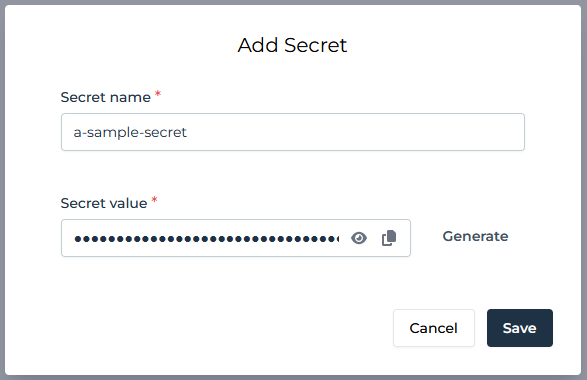 To update a secret, simply delete and recreate it. The trashcan icon allows for quick removal, with a confirmation prompt to prevent accidental deletion.
To update a secret, simply delete and recreate it. The trashcan icon allows for quick removal, with a confirmation prompt to prevent accidental deletion.
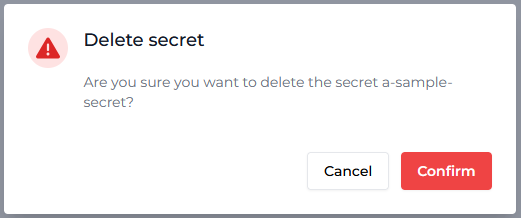
Glossary of Terms
Actuator Endpoints
System-level endpoints used for monitoring and diagnostics.
Case Instance (CAS)
A running instance of a case model, used to manage non-linear or event-driven workflows.
Dashboard
A visual interface in Flowable Hub that provides real-time metrics and operational insights across the automation environment.
Definition
A deployed model that serves as the blueprint for process or case execution.
DMN (Decision Model and Notation)
A standard for modeling decision logic, used in Flowable to define business rules.
Environment
The runtime section of Flowable Hub where deployed applications, instances, and system artifacts are monitored and managed.
Group
A collection of users organized by role, function, or team, used to simplify permission management.
Instance Migration
The process of transitioning running process or case instances to a new version of their definition.
Job
A background task in Flowable, such as timers or retries, categorized into Executable, Timer, Suspended, Deadletter, and History.
Model Hierarchy
A visual representation of how a process or case model fits into the broader design structure, including linked subprocesses.
OAuth2 Client
An external application or service configured to authenticate and interact with Flowable via secure API access.
Personal Access Token
A user-generated token used for authenticating API requests securely.
Process Instance (PRC)
A running instance of a process model.
Privilege
A specific permission granted to users or groups, defining what actions they can perform within Flowable applications.
Role
A predefined set of privileges assigned to users or groups to control access and capabilities.
Sandbox Environment
A non-production environment used for testing and experimentation without affecting live operations.
Secret
Sensitive data such as API keys or credentials stored securely within Flowable Hub.
Subprocess
A nested process or case within a larger workflow, used to modularize and reuse logic.
Task
A unit of work within a process or case, which can be assigned, delegated, or completed by users.
Token Mapping
The process of aligning execution steps between old and new definitions during instance migration.
User Profile
A record containing identity and access information for a Flowable user.
Work
The Flowable application responsible for executing and managing tasks, processes, and cases.